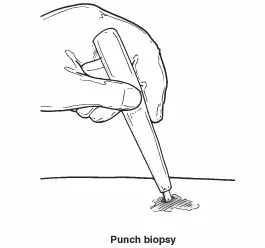What Is a Soft-Tissue Biopsy?
A soft-tissue biopsy is a medical procedure involving the extraction and microscopic analysis of a small sample of soft tissue for diagnostic purposes. Soft tissue encompasses the skin, fat, muscles, and tendons, which surround, connect, or support other bodily tissues and organs. Soft-tissue biopsies are minimally invasive and require little patient involvement, facilitating accurate diagnosis and treatment planning by foot and ankle surgeons.
Conditions Diagnosed by Soft-Tissue Biopsies
Soft-tissue biopsies are instrumental in identifying a range of conditions, including but not limited to:
- Freckles (macules)
- Benign pigmented or colored spots (moles or nevi)
- Fungal or bacterial infections
- Rashes (such as eczema or dermatitis)
- Lesions associated with systemic diseases (e.g., diabetes)
- Nodular conditions (e.g., ganglion cysts, lipomas, or fibromas)
- Toenail conditions (e.g., onychomycosis, psoriasis)
- Wart-like growths on the skin (benign keratoses)
- Premalignant conditions (actinic and seborrheic keratoses)
What Does the Biopsy Procedure Entail?
A soft-tissue biopsy procedure involves the extraction of a small tissue sample and typically lasts only a few minutes. The specific technique used depends on the tissue being sampled. After numbing the area, the surgeon may perform one of the following procedures:
Shave biopsy: In this method, a thin piece of tissue is shaved off.
Punch biopsy: A small, round instrument extracts a tiny core of tissue. Stitches may be necessary.
Incisional or excisional biopsy: In this approach, a piece or the entire lesion is removed, often requiring stitches.
After obtaining the sample, the surgeon sends it to a clinical laboratory for further analysis, with a specialized pathologist evaluating the soft-tissue biopsy.
Post-Biopsy Care
Patients should adhere to the post-biopsy care instructions provided by the surgeon. If stitches were used, an appointment will be scheduled for their removal. Typically, it takes several days for the laboratory results to reach the surgeon’s office. If the patient has not received the results within 10 days, they should contact the surgeon’s office. The biopsy results and any additional required treatments will then be discussed with the patient.






